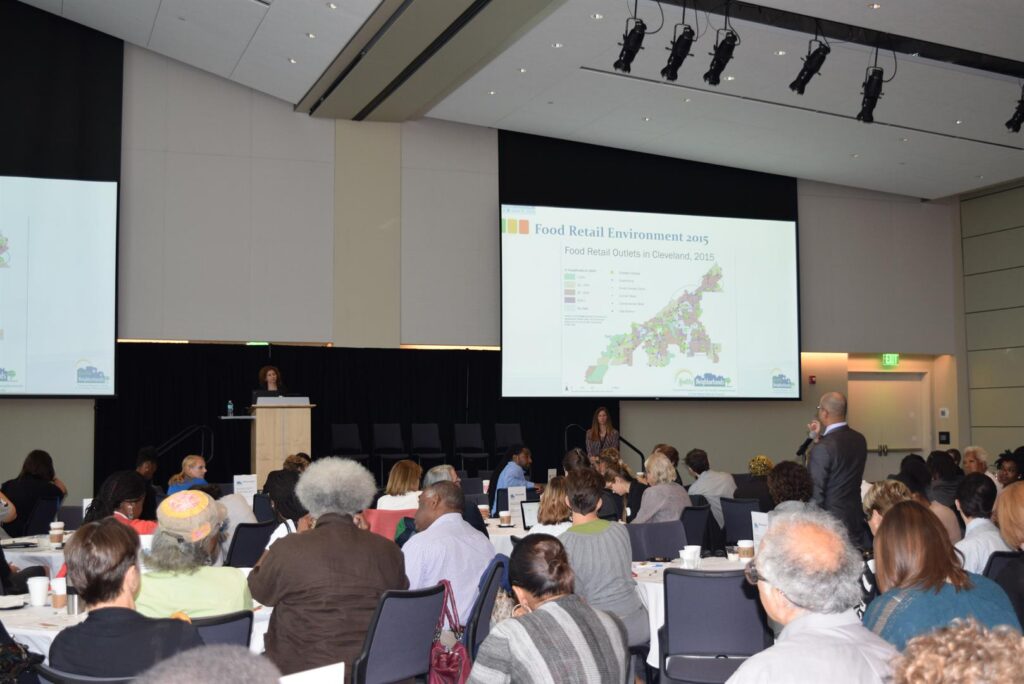The Prevention Research Center for Healthy Neighborhoods (PRCHN) held its inaugural Research Dissemination Day on September 14, 2016. Titled “Food Access and Food Security among Cleveland Residents,” the morning symposium brought together data from several of the PRCHN’s studies to tell the broader story of the city’s food environment. The PRCHN co-hosted the event with its Network of Community Advisors (NOCA).
After a welcome from NOCA co-chairs Brandon King and Lena Grafton, PRCHN researchers Sarah Jones, MS, RDN, LD, and Chaturia Rouse, MPH, MS, presented an overview of the diet quality of Cleveland’s youth and adult populations. Jones is the School, Community and Data Core Manager of the IMPACT study, a three-year intervention study working with overweight and obese middle-school-age students in the Cleveland school district. Rouse is the Program Manager for the Future of Food in Your Neighborhood Study (foodNEST), which is studying how changes to the food retail environment affect the health of a community. Both studies use 24-hour dietary recall interviews. Combined, they offer perhaps the most comprehensive overview of the actual diet quality of Cleveland residents available.
| Facilitator Nicole Debose answers a question during the full panel question & answer session |
| NOCA members and representatives from the Centers for Disease Control and Prevention (CDC) |
| An audience member asks a question after Associate Director Erika Trapl’s presentation. |
This dietary overview was followed by PRCHN Associate Director Erika Trapl, PhD, who used data from the PRCHN’s food retail audit project to examine access to healthy food across Cleveland neighborhoods. In 2012 and 2015, the PRCHN conducted full audits of food retail establishments in Cleveland, including large and small grocery stores, corner/convenience/gas station stores, and fast food establishments. The 2015 audit included more than 1,800 establishments in all part of the city, including downtown. Significant blocks of the city with high rates of SNAP utilization have access to very few grocery stores. However, these same areas are home to small groceries, corner stores, convenience stores, and gas stations. The Healthy Retail Initiative is working with these smaller stores to fill the perishable and healthy food gap to improve food access. To date, the Initiative has engaged with 15 stores who have added produce and other healthy items into their stores to increase access in their neighborhoods.
PRCHN Director Elaine Borawski, PhD, along with co-presenters Morgan Taggart, MUPD, of St. Clair Superior Development Corp, and Nicole Debose, MPA, MHA, Director of OSU Extension-Cuyahoga, discussed the results of a community-wide initiative to increase access to fresh produce in Cleveland.
The PRCHN was one of the original co-conveners of the Food Policy Coalition (FPC), which worked to increase the number of farmers’ markets in the city, encouraged markets to accept SNAP benefits, and introduced the Produce Perks Program, which allows SNAP users to receive $1 in fresh produce for every $1 they spent (up to $10) at a market.
Associate Director Darcy Freedman, PhD, discussed the first results of the PRCHN’s core research, FreshLink, which is evaluating and improving how people receiving SNAP benefits (Food Stamps) use farmers’ markets and the Double-Value Produce Perks program.
Finally, REACH Strategy Coordinator Kakul Joshi, MPH, discussed the Produce Prescription Program. The PRCHN is helping to implement a trial of 450 patients with hypertension at six community health clinics across the city with the objective of promoting community resources for fruits and vegetables and encouraging behavior change. The program evaluates patients’ utilization of farmers’ markets and change in fruit and vegetable consumption over a three-month period.
When the presentations were completed, the full panel took the stage for questions and a larger conversation with the more than 150 people in attendance. Food access and security is a multi-layered issue, and as such, the event brought together a range of individuals from university and hospital researchers to pharmacists and clinicians in community clinics to urban farmers and farmers’ market managers, to neighborhood development and nonprofit professionals, and members of the wider community. One participant summed the final discussion as “Breaking down the traditional barrier between presenter and audience. It really showed how food access is everyone’s issue.”

